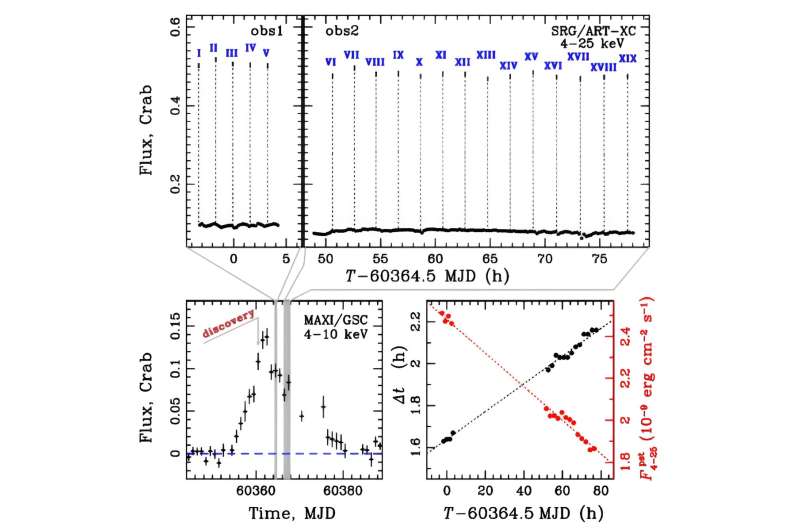May 7, 2024 report
This article has been reviewed according to Science X's editorial process and policies. Editors have highlighted the following attributes while ensuring the content's credibility:
fact-checked
preprint
trusted source
proofread
New accreting millisecond X-ray pulsar discovered

Astronomers report the discovery of a new pulsar using the Spektr-RG space observatory. The newfound object, designated SRGA J144459.2−604207 (or SRGA J1444 for short), turns out to be a bursting accreting millisecond X-ray pulsar. The finding was detailed in a paper published April 30 on the pre-print server arXiv.
X-ray pulsars exhibit strict periodic variations in X-ray intensity, which can be as short as a fraction of a second. Accreting millisecond X-ray pulsars (AMXPs) are a peculiar type of X-ray pulsars in which short spin periods are caused by long-lasting mass transfer from a low-mass companion star through an accretion disk onto a slow-rotating neutron star. Astronomers perceive AMXPs as astrophysical laboratories that could be crucial in advancing our knowledge about thermonuclear burst processes.
Now, a team of astronomers led by Sergey V. Molkov of Space Research Institute in Moscow, Russia, has found a new AMXP based on the observations conducted with Spektr-RG's Astronomical Roentgen Telescope X-ray Concentrator (ART-XC). The pulsar was detected on February 21, 2024, at the position close to the galactic plane.
"The intense follow-up campaign carried out immediately after the discovery revealed that SRGA J1444 is a new accreting millisecond pulsar with a spin period of 447.8 Hz, showing regular Type-I X-ray bursts," the researchers wrote in the paper.
Assuming that the mass of the neutron star in SRGA J1444 is 1.4 solar masses, the mass of the companion star is at least 0.25 solar masses. The system has a circular orbit with a period of approximately 5.2 hours and is estimated to be located some 27,000–35,000 light years away from the Earth.
The study found that the pulse profiles of the persistent emission of SRGA J1444 have interesting shapes showcasing a sine-like part during half a period with a plateau in between. The astronomers explained that these pulse profiles can be modeled by emission from two circular spots partially eclipsed by the accretion disk.
During ART-XC observations, 19 thermonuclear X-ray bursts were detected from SRGA J1444. It was noted that all the detected bursts have similar shapes and energetics and do not show any signs of photospheric radius expansion.
According to the paper, the burst rate decreases linearly from about one per 1.6 hours at the beginning of observations to about one per 2.2 hours at the end, while the energy release during the bursts remains approximately at the same level. Spectral evolution of SRGA J1444 during the burst suggests that the neutron star has a radius of about 11–12 kilometers.
The observations also detected pulsations during the bursts of SRGA J1444. However, the authors of the paper could not find a simple physical model explaining the pulse profiles detected during the bursts.
More information: S. V. Molkov et al, SRG/ART-XC discovery of SRGAJ144459.2-604207: a well-tempered bursting accreting millisecond X-ray pulsar, arXiv (2024). DOI: 10.48550/arxiv.2404.19709
Journal information: arXiv
© 2024 Science X Network





















